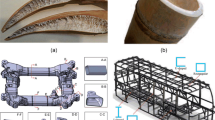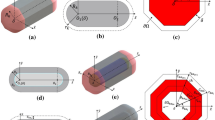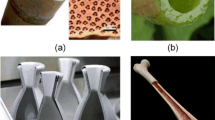Abstract
Hollow structures are widely used in industry because of the high stiffness-to-mass ratio and mature joining technology. However, in topology optimization (TO), the TO results are almost solid structures because the geometries of hollow structures cannot be represented in an explicit way. Therefore, this paper innovatively presents an explicit three-dimensional TO method to obtain the hollow structures using moving morphable components (MMCs), which is achieved by combining two topology description functions, namely, internal and external topology description functions. Especially, the combining topology description functions of the hollow component are derived for the first time. Compared to the solid TO results, the structural stiffness of the hollow TO results can be further improved. Finally, the TO problems of the three-dimensional square Mindlin cantilever plate, cantilever beam and miniature bending beam demonstrate the effectiveness of the proposed method.






























Similar content being viewed by others
References
Bendsøe MP (1989) Optimal shape design as a material distribution problem. Struct Optimization 1:193–202
Bendsøe MP, Kikuchi N (1988) Generating optimal topologies in structural design using a homogenization method. Comput Methods Appl Mech Eng 71:197–224
Chen W, Zuo WJ (2014) Component sensitivity analysis of conceptual vehicle body for lightweight design under static and dynamic stiffness demands. Int J Vehicle Des 66:107–123
Gui CY, Bai JT, Zuo WJ (2018) Simplified crashworthiness method of automotive frame for conceptual design. Thin Wall Struct 131:324–335
Guo X, Zhang WS, Zhong WL (2014) Doing topology optimization explicitly and geometrically-a new moving morphable components based framework. J Appl Mech 81:081009
Guo X, Zhang WS, Zhang J, Yuan J (2016) Explicit structural topology optimization based on moving morphable components (MMC) with curved skeletons. Comput Methods Appl Mech Eng 310:711–748
Hou WB, Gai YD, Zhu XF, Wang X, Zhao C, Xu LK, Jiang K, Hu P (2017) Explicit isogeometric topology optimization using moving morphable components. Comput Methods Appl Mech Eng 326:694–712
Liu C, Du ZL, Zhang WS, Zhu YC, Guo X (2017) Additive manufacturing-oriented Design of Graded Lattice Structures through Explicit Topology Optimization. J Appl Mech 84:081008
Liu C, Zhu YC, Sun Z, Li DD, Du ZL, Zhang WS, Guo X (2018) An efficient moving morphable component (MMC)-based approach for multi-resolution topology optimization. Struct Multidiscipl Optim 58:2455–2479
Lu SB, Ma HG, **n L, Zuo WJ (2019) Lightweight design of bus frames from multi-material topology optimization to cross-sectional size optimization. Eng Optimiz 51:961–977
Schutz M, Schwefel HP (2000) Evolutionary approaches to solve three challenging engineering tasks. Comput Methods Appl Mech Eng 186:141–170
Sethian JA, Wiegmann A (2000) Structural boundary design via level set and immersed interface methods. J Comput Phys 163:489–528
Steven G, Querin O, **e M (2000) Evolutionary structural optimisation (ESO) for combined topology and size optimisation of discrete structures. Comput Methods Appl Mech Eng 188:743–754
Sun JL, Tian Q, Hu HY (2018a) Topology optimization of a three-dimensional flexible multibody system via moving morphable components. J Comput Nonlinear Dyn 13:021010
Sun JL, Tian Q, Hu HY, Pedersen NL (2018b) Simultaneous topology and size optimization of a 3D variable-length structure described by the ALE-ANCF. Mech Mach Theory 129:80–105
Sun JL, Tian Q, Hu HY, Pedersen NL (2018c) Topology optimization of a flexible multibody system with variable-length bodies described by ALE-ANCF. Nonlinear Dynam 93:413–441
Svanberg K (1987) The method of moving asymptotes—a new method for structural optimization. Numer Methods Eng 24:359–373
Takalloozadeh M, Yoon GH (2017) Implementation of topological derivative in the moving morphable components approach. Finite Elem Anal Des 134:16–26
Wang MY, Wang XM (2004) “Color” level sets: a multi-phase method for structural topology optimization with multiple materials. Comput Methods Appl Mech Eng 193:469–496
Wang MY, Wang XM, Guo DM (2003) A level set method for structural topology optimization. Comput Methods Appl Mech Eng 192:227–246
Wang XY, Qi HB, Sun ZY, Wang XJ, Song XS, Wang JB, Guo X (2017) Quasi-continuum study of the buckling behavior of single-walled carbon nanocones subjected to bending under thermal loading. J Mater Res 32:2266–2275
Wang YG, Gao JC, Kang Z (2018) Level set-based topology optimization with overhang constraint: towards support-free additive manufacturing. Comput Methods Appl Mech Eng 339:591–614
**e YM, Steven GP (1993) A simple evolutionary procedure for structural optimization. Comput Struct 49:885–896
**e XD, Wang ST, Xu MM, Wang YJ (2018) A new isogeometric topology optimization using moving morphable components based on R-functions and collocation schemes. Comput Methods Appl Mech Eng 339:61–90
Xue RY, Li R, Du ZL, Zhang WS, Zhu YC, Sun Z, Guo X (2017) Kirigami pattern design of mechanically driven formation of complex 3D structures through topology optimization. Extreme Mech Lett 15:139–144
Zhang WH, Zhou L (2018) Topology optimization of self-supporting structures with polygon features for additive manufacturing. Comput Methods Appl Mech Eng 334:56–78
Zhang WS, Li D, Zhang J, Guo X (2016a) Minimum length scale control in structural topology optimization based on the moving morphable components (MMC) approach. Comput Methods Appl Mech Eng 311:327–355
Zhang WS, Yuan J, Zhang J, Guo X (2016b) A new topology optimization approach based on moving morphable components (MMC) and the ersatz material model. Struct Multidiscipl Optim 53:1243–1260
Zhang WS, Li D, Yuan J, Song JF, Guo X (2017a) A new three-dimensional topology optimization method based on moving morphable components (MMCs). Comput Mech 59:647–665
Zhang WS, Yang WY, Zhou JH, Li D, Guo X (2017b) Structural topology optimization through explicit boundary evolution. J Appl Mech 84:011011
Zhang WH, Zhou Y, Zhu JH (2017c) A comprehensive study of feature definitions with solids and voids for topology optimization. Comput Methods Appl Mech Eng 325:289–313
Zhang WS, Zhou JH, Zhu YC, Guo X (2017d) Structural complexity control in topology optimization via moving morphable component (MMC) approach. Struct Multidiscipl Optim 56:535–552
Zhang WS, Li D, Zhou JH, Du ZL, Li BJ, Guo X (2018a) A moving morphable void (MMV)-based explicit approach for topology optimization considering stress constraints. Comput Methods Appl Mech Eng 334:381–413
Zhang WS, Liu Y, Du ZL, Zhu YC, Guo X (2018b) A moving morphable component based topology optimization approach for rib-stiffened structures considering buckling constraints. J Mech Des 140:111404
Zhang WS, Song JF, Zhou JH, Du ZL, Zhu YC, Sun Z, Guo X (2018c) Topology optimization with multiple materials via moving morphable component (MMC) method. Int J Number Meth Eng 113:1653–1675
Zhou M, Rozvany G (1991) The COC algorithm, part II: topological, geometrical and generalized shape optimization. Comput Methods Appl Mech Eng 89:309–336
Zhou Y, Zhang WH, Zhu JH, Xu Z (2016) Feature-driven topology optimization method with signed distance function. Comput Methods Appl Mech Eng 310:1–32
Zhou LM, Ren SH, Liu CY, Ma ZC (2019a) A valid inhomogeneous cell-based smoothed finite element model for the transient characteristics of functionally graded magneto-electro-elastic structures. Compos Struct 208:298–313
Zhou Y, Zhang W, Zhu J (2019b) Concurrent shape and topology optimization involving design-dependent pressure loads using implicit B-spline curves. Int J Number Meth Eng 118:495–518
Zhu BL, Chen Q, Wang RX, Zhang XM (2018) Structural topology optimization using a moving morphable component-based method considering geometrical nonlinearity. J Mech Design 140:081403
Zuo WJ, Saitou K (2017) Multi-material topology optimization using ordered SIMP interpolation. Struct Multidiscipl Optim 55:477–491
Acknowledgments
This work was supported by the National Natural Science Foundation of China (Grant No. 51575226) and the Graduate Innovation Fund of Jilin University (Grant No. 101832018C195).
Author information
Authors and Affiliations
Corresponding author
Ethics declarations
Conflict of interest
The authors declare that they have no conflict of interest.
Additional information
Responsible Editor: Ji-Hong Zhu
Publisher’s note
Springer Nature remains neutral with regard to jurisdictional claims in published maps and institutional affiliations.
Electronic supplementary material
ESM 1
(RAR 95 kb)
Sensitivities of internal and external TDFs
Sensitivities of internal and external TDFs
The sensitivities of TDFs with respect to L can be calculated as follows:
The sensitivities of TDFs with respect to α can be calculated as follows:
with
and
The sensitivities of TDFs with respect to β or θ can be obtained by replacing ∂/∂α with ∂/∂β or ∂/∂θ. ∂T/∂β and ∂T/∂θ are derived as follows:
The sensitivities of TDFs with respect to x0 can be expressed as follows:
where
and
The sensitivities of TDFs with respect to y0 or z0 can be obtained by replacing ∂/∂x0 with ∂/∂y0 or ∂/∂z0.
The sensitivities of TDFs with respect to a1, cb1, and ct1 can be expressed as follows:
Rights and permissions
About this article
Cite this article
Bai, J., Zuo, W. Hollow structural design in topology optimization via moving morphable component method. Struct Multidisc Optim 61, 187–205 (2020). https://doi.org/10.1007/s00158-019-02353-0
Received:
Revised:
Accepted:
Published:
Issue Date:
DOI: https://doi.org/10.1007/s00158-019-02353-0




